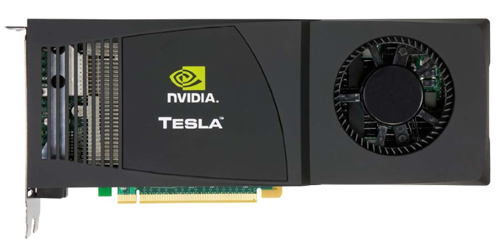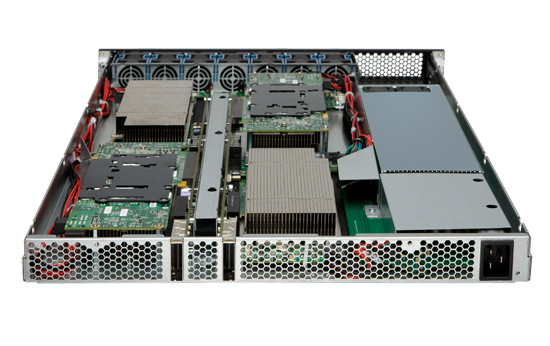NVIDIA's Fermi: Architected for Tesla, 3 Billion Transistors in 2010
by Anand Lal Shimpi on September 30, 2009 12:00 AM EST- Posted in
- GPUs
A Different Sort of Launch
Fermi will support DirectX 11 and NVIDIA believes it'll be faster than the Radeon HD 5870 in 3D games. With 3 billion transistors, it had better be. But that's the extent of what NVIDIA is willing to talk about with regards to Fermi as a gaming GPU. Sorry folks, today's launch is targeted entirely at Tesla.

A GeForce GTX 280 with 4GB of memory is the foundation for the Tesla C1060 cards
Tesla is NVIDIA's High Performance Computing (HPC) business. NVIDIA takes its consumer GPUs, equips them with a ton of memory, and sells them in personal or datacenter supercomputers called Tesla supercomputers or computing clusters. If you have an application that can run well on a GPU, the upside is tremendous.

Four of those C1060 cards in a 1U chassis make the Tesla S1070. PCIe connects the S1070 to the host server.
NVIDIA loves to cite examples of where algorithms ported to GPUs work so much better than CPUs. One such example is a seismic processing application that HESS found ran very well on NVIDIA GPUs. It migrated a cluster of 2000 servers to 32 Tesla S1070s, bringing total costs down from $8M to $400K, and total power from 1200kW down to 45kW.
| HESS Seismic Processing Example | Tesla | CPU |
| Performance | 1 | 1 |
| # of Machines | 32 Tesla S1070s | 2000 x86 servers |
| Total Cost | ~$400K | ~$8M |
| Total Power | 45kW | 1200kW |
Obviously this doesn't include the servers needed to drive the Teslas, but presumably that's not a significant cost. Either way the potential is there, it's just a matter of how many similar applications exist in the world.
According to NVIDIA, there are many more cases like this in the market. The table below shows what NVIDIA believes is the total available market in the next 18 months for these various HPC segments:
| Processor | Seismic | Supercomputing | Universities | Defence | Finance |
| GPU TAM | $300M | $200M | $150M | $250M | $230M |
These figures were calculated by looking at the algorithms used in each segment, the number of Hess-like Tesla installations that can be done, and the current budget for non-GPU based computing in those markets. If NVIDIA met its goals here, the Tesla business could be bigger than the GeForce one. There's just one problem:
As you'll soon see, many of the architectural features of Fermi are targeted specifically for Tesla markets. The same could be said about GT200, albeit to a lesser degree. Yet Tesla accounted for less than 1.3% of NVIDIA's total revenue last quarter.
Given these numbers it looks like NVIDIA is building GPUs for a world that doesn't exist. NVIDIA doesn't agree.
The Evolution of GPU Computing
When matched with the right algorithms and programming efforts, GPU computing can provide some real speedups. Much of Fermi's architecture is designed to improve performance in these HPC and other GPU compute applications.
Ever since G80, NVIDIA has been on this path to bring GPU computing to reality. I rarely get the opportunity to get a non-marketing answer out of NVIDIA, but in talking to Jonah Alben (VP of GPU Engineering) I had an unusually frank discussion.
From the outside, G80 looks to be a GPU architected for compute. Internally, NVIDIA viewed it as an opportunistic way to enable more general purpose computing on its GPUs. The transition to a unified shader architecture gave NVIDIA the chance to, relatively easily, turn G80 into more than just a GPU. NVIDIA viewed GPU computing as a future strength for the company, so G80 led a dual life. Awesome graphics chip by day, the foundation for CUDA by night.
Remember that G80 was hashed out back in 2002 - 2003. NVIDIA had some ideas of where it wanted to take GPU computing, but it wasn't until G80 hit that customers started providing feedback that ultimately shaped the way GT200 and Fermi turned out.
One key example was support for double precision floating point. The feature wasn't added until GT200 and even then, it was only added based on computing customer feedback from G80. Fermi kicks double precision performance up another notch as it now executes FP64 ops at half of its FP32 rate (more on this later).
While G80 and GT200 were still primarily graphics chips, NVIDIA views Fermi as a processor that makes compute just as serious as graphics. NVIDIA believes it's on a different course, at least for the short term, than AMD. And you'll see this in many of the architectural features of Fermi.










415 Comments
View All Comments
SiliconDoc - Thursday, October 1, 2009 - link
Sweet ! Nice pick, looks like carbon fiber at the bracket end.Wowzie, a real honker based on THOUSANDS OF DOLLARS of tech and core per part.
I feel SO PRIVLEDGED to have a chance at the gaming segment version, all that massive power jammed into a gaming card !
Whoo! U P S C A L E !
justaviking - Thursday, October 1, 2009 - link
Look at every bright area of high contrast. All the spotlight reflections have a red ring around them. So the thumb, in front of the highly reflective gold connectors, also has the same halo effect. I think that it's as much evidence of a digital camera as it is Photoshop manipulation.With that said, it could also be a non-functional mock-up. Holding a mock-up or prototype in your hand is not the same as benchmarking a production (ready for consumer release) product.
papapapapapapapababy - Thursday, October 1, 2009 - link
look at that irregular borders closely. ( above the watch) also, the shadows (finger) are off. thats a (terrible) shop.v1001 - Thursday, October 1, 2009 - link
All they did was blacken out the background more. Probably was more noise and distraction going on that they didn't want in there.justaviking - Thursday, October 1, 2009 - link
OK, so assuming it's a fake (and I'm not saying it isn't), I have three questions:1) Where did you get the photo?
2) Why do it? (And "Who did it?", but that's closely related to Q1.
3) Where did they get the photo of the hardware, which they then put into the person's hand?
Combining #2 and #3) If the card is from a real photo of real hardware, then what was the value of photoshopping it into someone's hand?
I'm not trying to argue, just trying to understand.
papapapapapapapababy - Thursday, October 1, 2009 - link
more fakes! source: bit-tech ( this one is even "better")http://i34.tinypic.com/34inz9j.jpg">http://i34.tinypic.com/34inz9j.jpg
also, not mine ( from xnews)
http://img28.imageshack.us/img28/2883/tesafilm.png">http://img28.imageshack.us/img28/2883/tesafilm.png
papapapapapapapababy - Thursday, October 1, 2009 - link
also below the card... whats that sloppy withe trim in the middle of a shadow? JAaAAAUNCjigga - Thursday, October 1, 2009 - link
Seriously? I have a 1080p monitor and Radeon 4670 with UVD2, but my PS3 with 1080p output to the same monitor looks MUCH better at upscaling DVDs (night and day difference.) PowerDVD does have a better upscaling tech, but that's using software decoding. Can somebody port ffdshow/libmpeg2 for CUDA and ATI Stream (or DirectCompute?) kthxbyePastuch - Thursday, October 1, 2009 - link
I buy two videocards per year on average. I've owned an almost equal number of ATI/Nvidia cards. I loved my geforce 8800 GTX despite it costing a fortune but since then it's been ALL down hill. I've had driver issues with home theater PCs and Nvidia drivers. I've been totally disappointed with Nvidias performance with high def audio formats. The fact that the entire ATI 48xx line can do 7.1 audio pass-through while only a handful of Nvidia videocards can even do 5.1 audio passthrough is just sad. The world is moving to hometheater gaming PCs and Nvidia is dragging arse.The fact that 5850 can do bitstreaming audio for $250 RIGHT NOW and is the second fastest 1 GPU solution for gaming makes it one hell of a product in my eyes. You no longer nead an Asus Xonar or Auzentech soundcard saving me $200. Hell with the money I saved I could almost buy a SECOND 5850! Lets see if the new Nvidia cards can do bitstreaming... if they can't then Nvidia won't be getting any more of my money.
P.S. Thanks Anand for inspiring me to build the hometheater of my dreams. Gaming on a 110 Inch screen is the future!
SiliconDoc - Thursday, October 1, 2009 - link
Well that's very nice, and since this has been declared the home of "only game fps and bang for that buck" matters, and therefore PhysX, ambient occlusion, CUDA, and other nvidia advantages, and your "outlier" htpc desires are WORTHLESS according to the home crowd, I guess they can't respond without contradiciting themselves, so I will considering I have always supported added value, and have been attacked for it.--
Yes, throw out your $200 sound cards, or sell them, and plop that heat monster into the tiny unit, good luck. Better spend some on after market cooling, or the raging videocard fan sound will probably drive you crazy. So another $100 there.
Now the $100 you got for the used soundcard is gone.
I also wonder what sound chip you're going to use then when you aren't playing a movie or whatever, I suppose you'll use your motherboard sound chip, which might be a lousy one, and definitely is lousier than the Auzentech you just sold or tossed.
So how exactly does "passthrough" save you a dime ?
If you're going to try to copy Anand's basement theatre projection, I have to wonder why you wouldn't use the digital or optical output of the high end soundcard... or your motherboards, if indeed it has a decent soundchip on it, which isn't exactly likely.
-
Maybe we'll all get luckier,and with TESLA like massive computing power, we'll get an NVIDIA blueray dvd movie player converter that runs on the holy grail of the PhysX haters, openCL and or direct compute, and you'll have to do with the better sound of your add on sound cards, anyway, instead of using a videocard as a transit device.
I can't imagine "cable mamnagement" as an excuse either, with a 110" curved screen home built threate room...
---
Feel free to educate me.